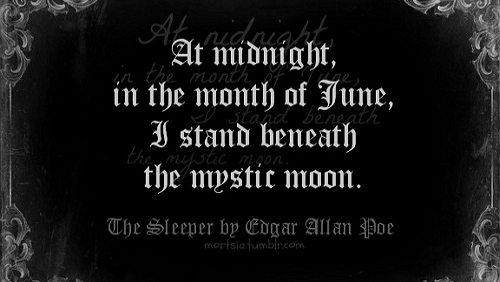 Halloween is upon us again, and to get into the spirit, I thought I would head over to my bookcase and re-read a scary story or two. As a big fan of the great Victorian Gothic novels – “Dracula” and “Frankenstein” – I thought I would delve a little into the origins of Gothic literature and explore why these books remain so popular.
Halloween is upon us again, and to get into the spirit, I thought I would head over to my bookcase and re-read a scary story or two. As a big fan of the great Victorian Gothic novels – “Dracula” and “Frankenstein” – I thought I would delve a little into the origins of Gothic literature and explore why these books remain so popular.
Principally, “Gothic” refers to a style of architecture which developed during the Middle Ages; featuring tall, pointed windows, stained glass, flying buttresses, and soaring spires. During the late seventeenth century, a revival in interest of all things medieval led to the term “Gothic” becoming synonymous with anything ancient and arcane. As regards literature, the first use of the term was by Horace Walpole, whose 1765 novel “The Castle of Otranto” was subtitled “A Gothic Story”, primarily because it was set in an ancient castle.
The narrative of a dark, forbidding castle or mansion, melodramatic plot, sinister aristocracy and supernatural occurrences, essentially became the format of what was to become an enduringly popular genre. Playing upon fundamental fears of death, terror, madness and chaos, Walpole’s book was a huge success and led to a host of imitators, most notably Ann Radcliffe, whose novels “The Mysteries of Udulpho” (1794) and “The Italian” (1797) are considered some of the finest examples of Gothic literature.
The huge social, psychological and political upheavals occurring in Europe during the late Eighteenth and early Nineteenth centuries, provided fertile ground for the development of Gothic novels, manipulating ancient fears as well as the assumed corruption of the upper classes. The publication of “The Monk” by Matthew Gregory Lewis in 1798, introduced graphic descriptions of sexual violence, murder and devil worship into the genre – expanding on the premise of a young, innocent (usually female) victim, seduced and betrayed by a mysterious, sinister force.
The success of Mary Shelley’s “Frankenstein” (1818), brought new perspectives into the Gothic genre – the power and danger of the scientific method, and the prevalent, psychological fear of confrontation with a corrupt “double” – later adopted, to chilling effect, by Robert Louis Stevenson in “The Strange Case of Dr Jeckyll and Mr Hyde” (1886); as well as by Edgar Allan Poe. It is interesting to note, that within this transformative period of Victorian England, the popularity of mesmerism and spiritualism, as well as a fascination with death and its rituals was at its highest.
Apart from “Frankenstein” the most famous example of Victorian Gothic is Bram Stoker’s “Dracula” (1897). Stoker introduced the vampire as a representation of the turmoil of the age – medieval superstition thwarted by scientific reason – “ancient” Europe destroyed by “modern” London. Dracula’s ability to move around undetected, infecting others with his “disease”, represented the fears of many late Victorians about increased immigration – a result of revolutions (both political and industrial) – and the subsequent rise of crime and ghetto communities. For Stoker, the vampire was an evil, pervasive entity, spreading corruption and depravity among the civilized and respectable. In comparison, the modern depiction of the vampire, as an anaemic, romantic hero, could be seen as a symptom of our nostalgia for a simpler, more “romantic” time.
 By the late nineteenth and early twentieth centuries, Gothic influences could be seen in otherwise “mainstream” literature. Both Emily and Charlotte Bronte used supernatural elements in their work. “Wuthering Heights” and “Jane Eyre” both include scenes where the protagonists fear a ghostly presence which ultimately has a rational explanation. Similarly, “The Woman in White” (1865) by Wilkie Collins – one of the first “sensational” best-sellers – revolves around a fear of the supernatural, again overcome by reason and fact. In “Great Expectations”, Charles Dickens incorporated the dark, sinister, atmospheric tone and the eerie characters of Magwitch and Miss Havisham, to add a Gothic twist to his tale.
By the late nineteenth and early twentieth centuries, Gothic influences could be seen in otherwise “mainstream” literature. Both Emily and Charlotte Bronte used supernatural elements in their work. “Wuthering Heights” and “Jane Eyre” both include scenes where the protagonists fear a ghostly presence which ultimately has a rational explanation. Similarly, “The Woman in White” (1865) by Wilkie Collins – one of the first “sensational” best-sellers – revolves around a fear of the supernatural, again overcome by reason and fact. In “Great Expectations”, Charles Dickens incorporated the dark, sinister, atmospheric tone and the eerie characters of Magwitch and Miss Havisham, to add a Gothic twist to his tale.
The enduring popularity of Gothic literature, as well as films and even music, in our modern era of iPhones and self-driving cars indicates, I think, that while technology might help to make our lives cleaner, brighter and shinier; there remains within us all a desire to, just briefly, step out of the light, and embrace the arcane, seductive power of our darkest fears.








Gordon
Very informative. I love gothic architecture and things that inspire the steampunk genre
Andrea Post author
Thanks bro! I think the steampunk trend is v cool!